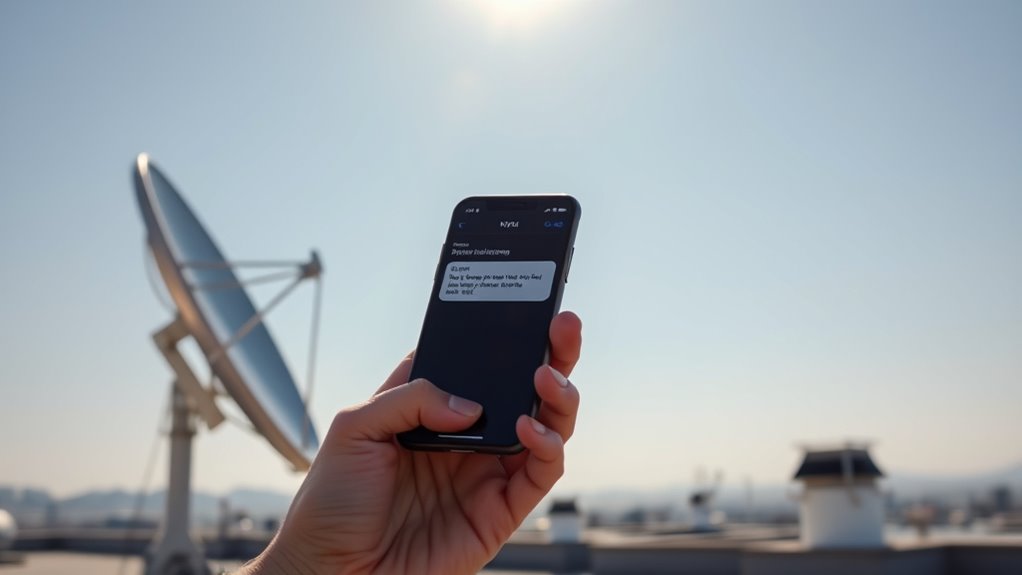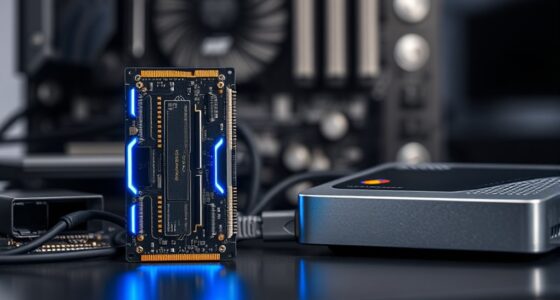Satellite-to-phone SMS works through non-terrestrial networks by using satellites as relay points, connecting your device directly to remote areas without traditional cell towers. When you send a message, ground stations convert it into radio signals that satellites amplify and transmit to your phone. This system guarantees seamless two-way messaging even in isolated or disaster-affected regions. To explore how these components work together, keep going to uncover the detailed process behind NTN communication.
Key Takeaways
- Satellite-to-phone SMS uses satellites as relay points to connect mobile devices in remote areas without terrestrial networks.
- Ground stations convert messages into radio signals compatible with satellite frequencies for transmission.
- Satellites amplify, process, and relay signals to target devices, ensuring message integrity and delivery.
- Two-way communication allows users to send and receive SMS messages globally, even in off-grid locations.
- Challenges include latency and weather interference, with future upgrades aiming to enhance speed, coverage, and reliability.
Understanding Non-Terrestrial Networks (NTN)
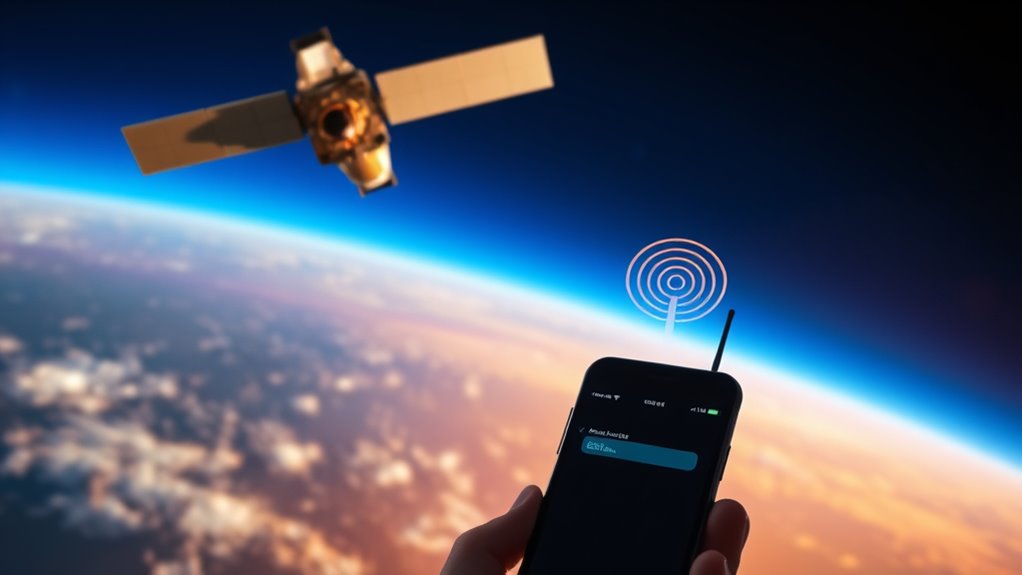
Non-Terrestrial Networks (NTNs) refer to communication systems that operate beyond traditional ground-based infrastructure, including satellites, high-altitude platforms, and airborne nodes. Instead of relying solely on cell towers, NTNs use space-based or elevated platforms to provide connectivity. You can think of NTNs as the backbone that extends your network coverage to remote or hard-to-reach areas. They enable communication over vast distances, ensuring signals reach places where ground infrastructure is limited or nonexistent. By using satellites or high-altitude devices, NTNs help bridge gaps in coverage and maintain reliable links. This technology plays a vital role in expanding communication networks, especially in emergency situations or rural regions where traditional infrastructure may be unavailable or impractical. Additionally, advancements in satellite technology are continually enhancing the capacity and reliability of NTNs.
How Satellites Enable Direct Phone Communication

Satellites play a key role in enabling direct communication between phones and space-based networks. They act as relay points, connecting your device to remote regions without traditional cell towers. Here’s how they do it:
Satellites enable direct phone connections in remote areas without traditional cell towers.
- Signal Reception: Satellites receive your phone’s signals via specialized antennas, even from remote or underserved areas.
- Data Transmission: They then forward this data to ground stations or other satellites, bridging the gap between your phone and the broader network.
- Bidirectional Communication: Satellites facilitate two-way communication, ensuring your messages reach their destination and responses come back quickly.
- Enhanced Coverage Capabilities: This system eliminates the need for nearby terrestrial infrastructure, providing reliable connectivity in places where standard networks can’t reach. By doing so, satellites enable direct, seamless communication no matter where you are.
The Technology Behind Satellite-to-Phone SMS

The technology behind satellite-to-phone SMS relies on a combination of advanced radio frequencies, specialized transponders, and precise signal processing. Your message travels from your phone to a ground station, which converts it into radio signals compatible with satellite frequencies. The satellite then receives these signals using its transponders, which amplify and relay them toward the destination. To guarantee accurate delivery, the system employs sophisticated signal processing techniques that manage timing, frequency shifts, and data encoding. This process minimizes delays, reduces errors, and maintains message integrity across vast distances. Signal processing techniques are crucial for adapting to the dynamic conditions of satellite communication channels. The entire system is designed to handle high volumes of messages efficiently, ensuring your SMS reaches recipients even in remote or off-grid locations where traditional networks don’t reach.
Components of Satellite-to-Phone SMS Systems
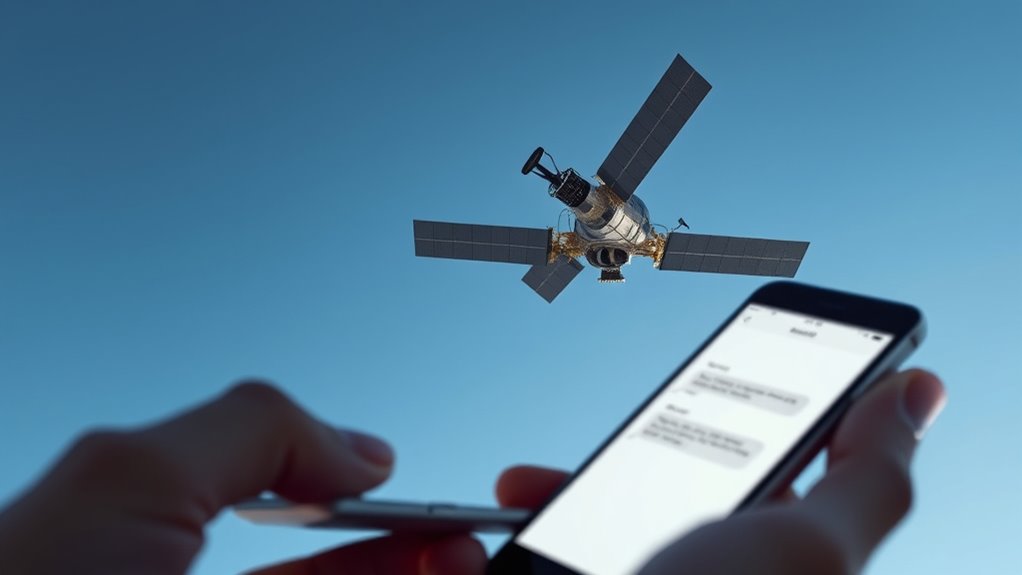
Understanding the components of satellite-to-phone SMS systems reveals how each part works together to deliver messages reliably. First, the satellite acts as the relay, receiving signals from the network and transmitting them to your phone. Second, ground infrastructure includes gateways and control centers that manage communication flow and guarantee message accuracy. Third, your mobile device contains a satellite-compatible modem that receives and displays the SMS. These components work in harmony through:
- Satellite transponders that handle signal relay.
- Ground stations coordinating message routing.
- Mobile device modems decoding satellite signals.
Additionally, space-based communication systems are designed to operate effectively across various environments, ensuring reliable messaging even in remote areas. Each element plays an essential role in bridging the gap between space-based technology and your phone, ensuring messages are transmitted smoothly even in remote areas. This interconnected system provides seamless communication where traditional networks can’t reach.
Signal Transmission: From Satellite to Mobile Device
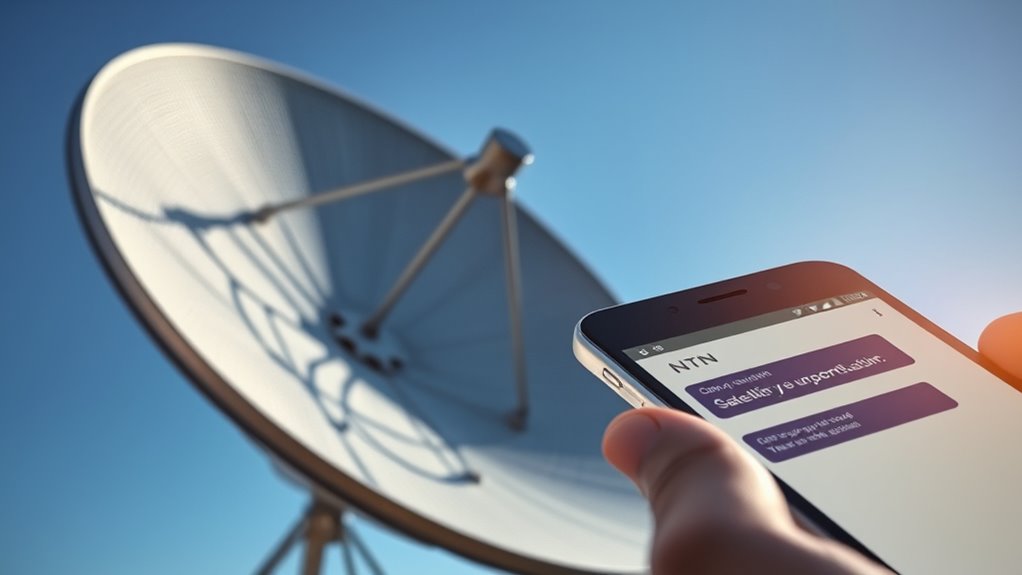
Once the ground infrastructure processes and forwards your SMS, the next step involves transmitting the message from the satellite to your mobile device. The satellite uses a powerful radio signal to reach your device’s antenna. It broadcasts the message over a specific frequency, ensuring it reaches the correct handset. Your phone’s receiver picks up this signal, which is then converted into a digital format your device can understand. The transmission relies on precise timing and strong signal strength, especially since satellites are often in orbit, which can introduce delays. The satellite’s antenna directs the message toward your device’s location, maximizing efficiency. Once received, your phone processes the signal and displays the SMS, completing the transmission from satellite to your mobile device. Additionally, signal transmission involves complex timing mechanisms to ensure the message arrives accurately and promptly.
Challenges and Limitations of NTN Messaging

Non-terrestrial network (NTN) messaging faces several significant challenges that can hinder reliable communication. First, signal latency increases because signals travel longer distances, causing delays that may affect real-time messaging. Second, coverage gaps occur in remote or obstructed areas where satellite signals struggle to reach, limiting accessibility. Third, interference from weather conditions like storms or heavy rain can weaken signals, reducing message clarity and delivery success. Additionally, enhanced signal technology is needed to improve transmission reliability in difficult environments. These obstacles mean that, despite advancements, NTN messaging still faces reliability issues. You might experience delays or missed messages, especially in challenging environments. Overcoming these limitations requires ongoing technological improvements, but for now, you should be aware of these inherent challenges when using satellite-to-phone SMS.
Future Developments in Satellite-Based Communication
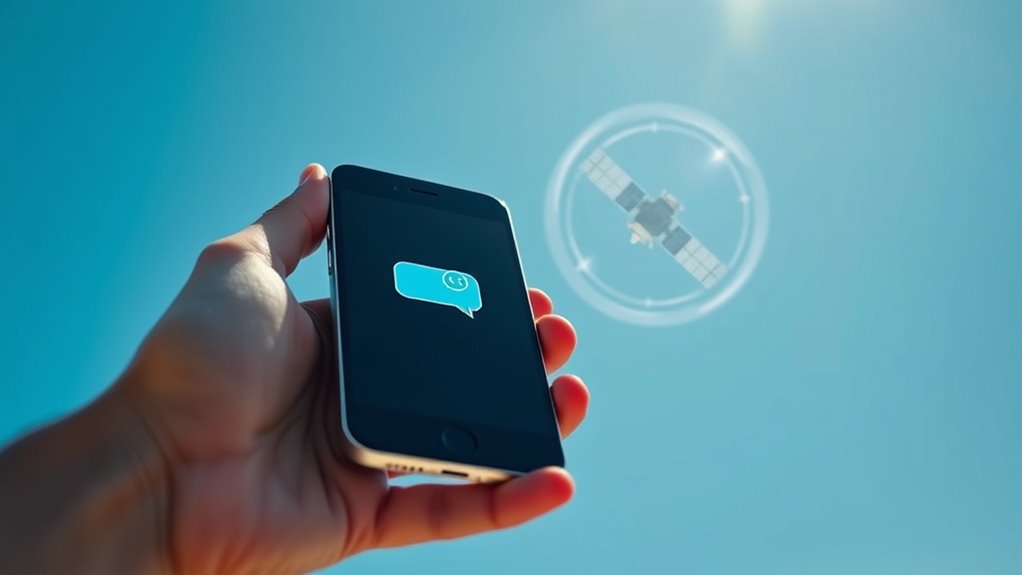
Advancements in satellite technology are paving the way for more reliable and widespread communication services. Future developments will likely include higher-frequency bands, such as millimeter waves, to increase data capacity and speed. You can expect more sophisticated satellite constellations, offering lower latency and better coverage, especially in remote areas. Innovations in miniaturization will make satellites smaller and more affordable, enabling rapid deployment of new networks. Additionally, integration of AI and automation will optimize signal routing, improve network resilience, and facilitate real-time management. These improvements aim to make satellite-based communication more seamless, resilient, and accessible. As a result, you’ll benefit from faster connections, broader coverage, and more reliable messaging, even in the most challenging environments.
Real-World Applications and Benefits of NTN SMS
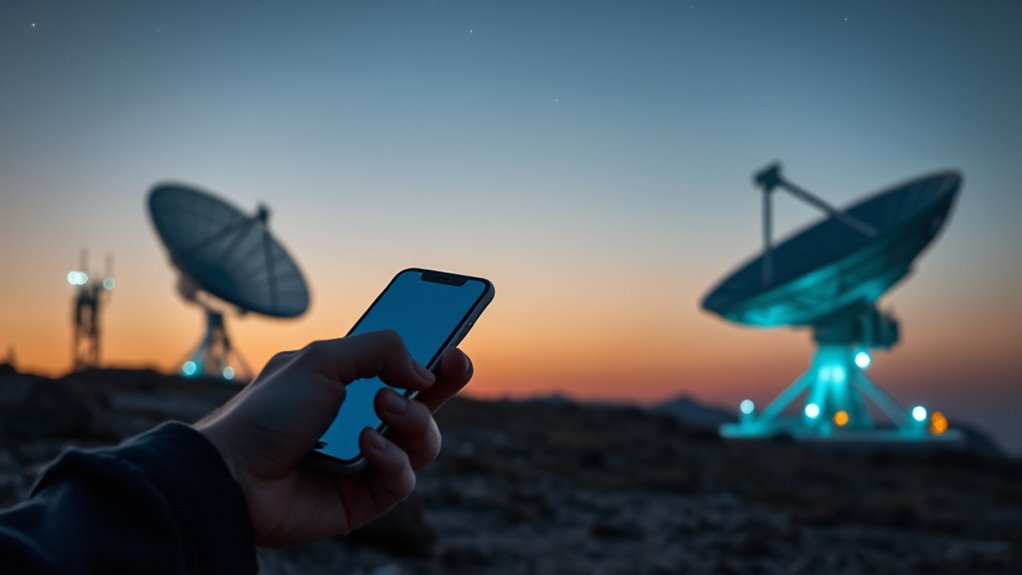
Non-terrestrial network (NTN) SMS opens new opportunities for reliable communication in remote and underserved areas where traditional cell towers are unavailable. This technology guarantees you stay connected during emergencies, disaster responses, or in isolated locations. Its real-world applications include:
- Emergency alerts that reach people in disaster zones when terrestrial networks fail
- Remote monitoring for industries like agriculture, mining, and maritime operations
- Enhanced connectivity for travelers and astronauts in areas beyond terrestrial coverage
Furthermore, curated recommendations ensure that users can identify the most reliable NTN solutions tailored to their specific needs. These benefits mean you can depend on secure, timely messages regardless of your location. NTN SMS bridges gaps in communication infrastructure, offering critical support in situations where traditional networks can’t reach. It’s a game-changer for safety, connectivity, and operational efficiency across various sectors.
Frequently Asked Questions
How Secure Is Satellite-To-Phone SMS Communication?
You might wonder about the security of satellite-to-phone SMS communication. It’s generally quite secure because messages are encrypted during transmission, preventing unauthorized access. However, like any technology, it’s not entirely foolproof—possible risks include interception or hacking if encryption protocols are weak or compromised. To stay safe, use strong encryption methods and keep your devices updated. Overall, satellite SMS offers a reliable, secure way to communicate in remote or challenging environments.
What Are the Latency Differences Compared to Terrestrial Networks?
Latency levels linger longer in satellite-to-phone SMS than in terrestrial networks. You’ll notice noticeable lag, especially in remote regions, because signals travel through space and multiple relay points before reaching your device. Terrestrial networks offer faster, more immediate exchanges thanks to direct, ground-based connections. So, while satellite messaging provides coverage where others can’t, it tends to trade speed for extended reach, leading to increased latency and delayed delivery.
Can NTN SMS Work in Remote or Disaster-Stricken Areas?
In remote or disaster-stricken areas, NTN SMS can be a lifesaver. Since it relies on satellite networks rather than local infrastructure, you can send and receive messages even when terrestrial networks are down. This means you’re more connected during emergencies or in hard-to-reach places. You just need a compatible device and clear satellite reception, making communication possible when traditional methods fail.
What Devices Are Compatible With Satellite-To-Phone SMS?
Think of satellite-to-phone SMS like sending a message through a global relay race. You need a compatible device, such as certain smartphones equipped with satellite communication capabilities or specialized satellite phones. Many modern devices support this technology through add-on modules or apps. Check with your provider or device specifications to guarantee compatibility, so you can stay connected anywhere, even where cellular networks fail.
How Does Weather Affect Satellite-Based SMS Delivery?
Weather can impact satellite-based SMS delivery by causing signal disruptions. Heavy rain, snow, or storms create atmospheric interference that weakens satellite signals, leading to delays or message failures. You might notice your texts don’t go through during severe weather. To minimize issues, try sending messages when the weather improves or make certain your device has a clear line of sight to the satellite. Still, some delays are unavoidable in extreme conditions.
Conclusion
Imagine sending a message across mountains and oceans, bridging distances once thought impossible. Satellite-to-phone SMS turns that vision into reality, connecting you even in remote places. As technology advances, it’s like opening new doors to communication, making the world feel smaller and more connected. Just like a lighthouse guides ships safely home, NTN guarantees your messages reach their destination, no matter where you are—proving that distance is no longer a barrier.
